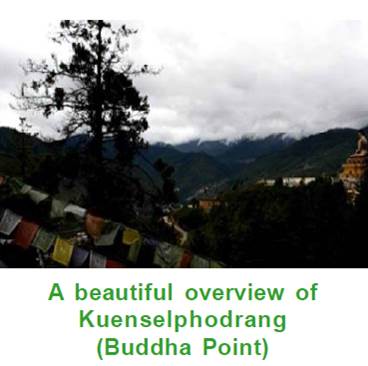|
Bhutan: In Pursuit of Sustainable Development B hutan and its Natural BiodiversityBhutan is endowed with an outstanding natural environment. It is dubbed as the ‘crown jewel’ of the Eastern Himalayas, a region recognised as a global biodiversity hotspot. Broadly speaking, the natural habitats range from the subtropical broadleaf forests and grasslands through temperate mountain forests to alpine meadows interspersed with marshlands and various water bodies. Despite a nascent conservation research capacity, the country has hitherto recorded 5,603 species of vascular plants, including 369 species of orchids and 46 species of rhododendrons 1. Of the recorded plant species, 105 species are endemic – found nowhere else in the world. Mammal species in the wild number close to 200 and these include some of the world’s most threatened species such as the Bengal Tiger, Snow Leopard, Asian Elephant, Red Panda, Golden Langur, and Takin, the country’s national animal. Bird fauna is also outstanding. 678 species have been recorded, including 14 that are globally threatened.To maintain the rich natural biodiversity, 42.71% of
the country has been declared as protected, which includes five national
parks, four wildlife sanctuaries and a strict nature reserve. Forests
account for more than 70% of the country’s land cover – one of the
highest in the world. As a result of the vast forest cover and limited
number of polluting industries, Bhutan is among the few countries in the
world with net greenhouse gas (GHG) emission in negative. Forest resources and biodiversity constitute the country’s most important natural resource. The country’s biodiversity is a major source of livelihood for the country’s rural communities who live in close interaction with their natural environment. Rural artisans produce bamboo and cane handicrafts, various kinds of woodwork and textiles using natural dye for income generation. In addition, local people collect a wide range of edible, medicinal and aromatic plants for cash income. Bhutan and MDGs In Bhutan, the MDGs have contributed to the long-term realisation of Gross National Happiness (GNH), which is the guiding development philosophy in the country. The core pillars of GNH are as follows: • Equitable and sustainable socio-economic development• Conservation of the natural environment• Preservation and promotion of culture• Good governanceBhutan has achieved most of the MDG targets, as it successfully aligned the MDGs with national priorities and integrated them into the national development planning framework. Also, the development philosophy of GNH provided an enabling environment to mainstream the MDGs. Conservation Measures taken by the Government Conservation of the natural environment being one of the four pillars of the Gross National Happiness (GNH) philosophy, Bhutan strives to preserve more than 60% forest cover in its constitution which is indeed achieved with more than 70% at present. Bhutan has developed and implemented three Biodiversity Action Plans, the first in 1998, the second in 2002 and the third in 2009. The implementation in regard to the latter is still in process. Also the country has been constantly moving forward with environmental conservation initiatives to keep its forest cover intact. The recent adoption of the Bio Safety Bill, 2014 in the parliament is also a welcoming step by the Bhutanese parliamentarians. People’s Initiatives In parallel with the government’s efforts, the Bhutanese people too are taking conservation initiatives. June 2nd, the coronation day of the Fourth Druk Gyalpo, Jigme Singye Wangchuck is also celebrated nationwide as the ‘Social Forestry Day’. The most trending example is the People’s Initiative in Celebrating the Sixtieth Anniversary (PICSA) of His Majesty, the Fourth Druk Gyalpo in collaboration with the Ministry of Agriculture and Forests this year. This initiative will see 100 men carry out a mass tree plantation drive to plant 50,000 trees within an hour in an attempt to enter the Guiness Book of World Record. Bhutan’s story of progress needs to be credited to its natural resources. Through strong leadership of valuing its natural resources as an irreplaceable asset and by learning from other countries’ mistakes in natural resource management, Bhutan has achieved a sustainable path towards development. q Krishna Ghalley Endnote 1 All species and protected area figures are cited from the Biodiversity Action Plan of Bhutan 2009. Reference: |
